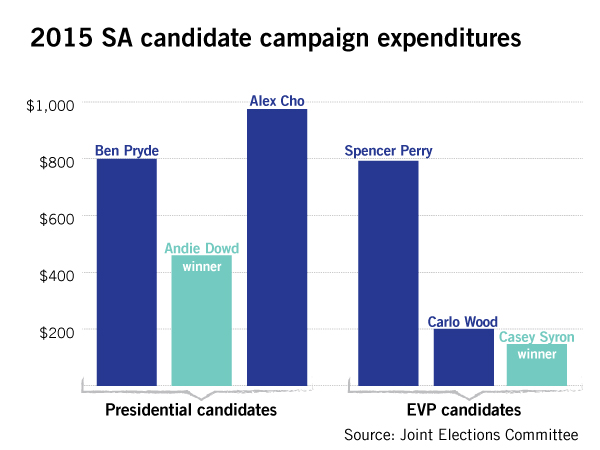Updated: April 6, 2015 at 1:39 p.m.
This year’s winners in the races for the Student Association’s top two posts show that victory and heavy campaign spending don’t always go hand in hand.
Both candidates elected to the SA’s top spots spent the least compared to their competitors. Andie Dowd, who clinched the presidency with more than 52 percent of the vote, spent less than $500 on her campaign. Casey Syron, who will be the SA’s next executive vice president, spent less than $150, an amount he said he thought was still too much.
“My goal was to only spend $100 because I work two jobs, so I pay for everything myself,” Syron said. “So I was kind of upset because I went over it by $47.”
Syron put the majority of his money toward his website, which he designed himself using an online hosting service. Those costs totaled $55, more than a third of his total expenses. He also paid for posters, a dry erase board, a marker, chalk and tape.
Historically, SA election winners have spent more than their competitors. Presidential and EVP candidates can spend or claim up to $1,000 worth of expenses. U-at-Large senate candidates are capped at $750 and all other senate candidates can spend up to $500.
Past winning presidential candidates have neared the spending limits, with Julia Susuni spending more than $960 in 2013 – which was more than double the amount her competitors spent combined. Four out of the five 2011 presidential hopefuls spent more than $900 on their campaigns.
SA President Nick Gumas spent more than $750 last year, while his competitor spent about $400. EVP Avra Bossov claimed more than $960 in expenditures. The other two EVP candidates spent $240 and $28.
Ben Pryde, the runner-up in this year’s presidential race, has declined to provide the Joint Elections Committee with his expenditures report, violating JEC rules. Zachary Speck, the chair of the JEC, said the group will not pursue charges against Pryde because the hearing would have no impact on the outcome of an election.
Pryde said in a phone interview that he spent about $800 on his campaign, with the majority of his funds covering the costs of t-shirts and printing for posters and palm cards.
He said he hadn’t submitted his expenditure form because he had been busy preparing for SA finance committee allocations, a process that he helps to lead, as well as catching up on other responsibilities he had neglected during the campaign.
Alex Cho, who lost a bid for SA president, spent about $975 on his campaign. That spending included $50 on a rap about his campaign produced by his friend. Cho spent more than $420 on 120 posters and 3,000 flyers, and an additional $79.85 on 100 buttons.
Carlo Wood, an SA senator who ran for EVP, said he will propose a bill at the senate’s next meeting to cap spending at half the current amounts. A similar bill was considered in January but failed to pass.
Wood, who spent more than $200 on his campaign, said this year’s races prove that students don’t need to spend as much money as they have in the past to win.
“Essentially our main fight is that there’s really no correlation between the amount of money that you spend and the amount of votes you get,” Wood said.
Dowd said she would support more limits on campaign spending because of how large a sum $1,000 is to a college student. She claimed a $459 for her winning campaign — which she used to buy palm cards, Facebook Ads, posters and buttons.
Dowd said her and Syron’s relatively low spending could set a precedent for future student leaders.
“It’s really encouraging and encourages other people to do the same,” she said.
Spencer Perry, who spent close to $800 on his EVP campaign, said he is a low-income student and he saved up the money he earned from his job as a GW academic technician to cover his costs.
He said he had no regrets about spending as much as he did because he knew the kind of campaign he wanted to run – one that was strategic and modeled after previous successful bids.
The majority of what he claimed went toward posters, palm cards and buttons, but he said the posters were free and the cost of the buttons were cut in half after he had problems with the company that made them.
“For me, I just knew that if I was going to do it, I was going to do it right,” Perry said.







